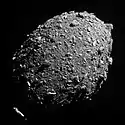2022 UR4
2022 UR4 is a small near-Earth asteroid that made an extremely close approach within 0.044 lunar distances (17,000 km; 11,000 mi) from Earth's center on 20 October 2022 at 22:45 UTC.[4] It was discovered about 14 hours before closest approach by the Asteroid Terrestrial-impact Last Alert System (ATLAS) survey telescope at Mauna Loa Observatory, Hawaii on 20 November 2022.[2] During the close approach, the asteroid passed above the northern hemisphere of Earth and reached a peak brightness of magnitude 10,[2] just 40 times fainter than the threshold of naked eye visibility.[lower-alpha 1]
| Discovery[1][2] | |
|---|---|
| Discovered by | ATLAS-MLO |
| Discovery site | Mauna Loa Obs. |
| Discovery date | 26 November 2022 |
| Designations | |
| 2022 WM7 | |
| A10OBKV[3] | |
| NEO · Apollo[1] | |
| Orbital characteristics[4] | |
| Epoch 25 February 2023 (JD 2460000.5) | |
| Uncertainty parameter 6 | |
| Observation arc | 13.56 hours[1] |
| Aphelion | 2.701 AU |
| Perihelion | 0.831 AU |
| 1.766 AU | |
| Eccentricity | 0.5294 |
| 2.35 yr (857.0 days) | |
| 36.030° | |
| 0° 25m 12.279s / day | |
| Inclination | 11.292° |
| 207.182° | |
| December 2022[4] | |
| 238.577° | |
| Earth MOID | 0.000407 AU (60,900 km; 0.158 LD) |
| Jupiter MOID | 2.641 AU |
| Physical characteristics | |
Mean diameter | 4.4–9.9 m (assumed albedo 0.05–0.25)[5] |
| 28.90±0.45[4] | |
Notes
- The faintest magnitude that can be seen with the naked eye is about 6.[6] Using the formula Δm = −2.5 log10(F1/F2),[6] where Δm = m1 – m2 = 6 – 10 = –4 is the magnitude difference between the naked eye limit and 2022 UR4's peak brightness, the brightness ratio F1/F2 of the naked eye limit to the peak brightness of 2022 UR4 is approximately 39.81 ≈ F1/F2 = 10(Δm/–2.5).
References
- "2022 UR4". Minor Planet Center. Retrieved 30 November 2022.
- "MPEC 2022-U145 : 2022 UR4". Minor Planet Electronic Circular. Minor Planet Center. 21 October 2022. Retrieved 30 November 2022.
- "2022 UR4". NEO Exchange. Las Cumbres Observatory. 20 October 2022. Retrieved 30 November 2022.
- "JPL Small-Body Database Browser: (2022 UR4)" (2022-10-20 last obs.). Jet Propulsion Laboratory. Retrieved 30 November 2022.
- "Asteroid Size Estimator". Center for Near Earth Object Studies. NASA. Retrieved 30 November 2022.
- Mihos, Chris (2005). "The Magnitude Scale". Case Western Reserve University. Retrieved 30 November 2022.
External links
- 2022 UR4 at NeoDyS-2, Near Earth Objects—Dynamic Site
- 2022 UR4 at ESA–space situational awareness
- 2022 UR4 at the JPL Small-Body Database
This article is issued from Wikipedia. The text is licensed under Creative Commons - Attribution - Sharealike. Additional terms may apply for the media files.

